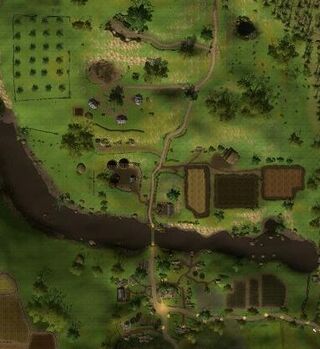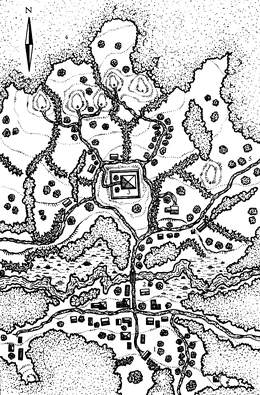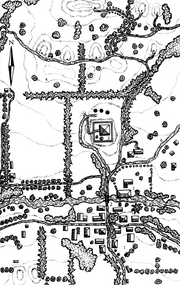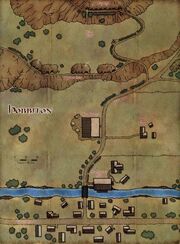
Hobbiton Overview
Hobbiton was a prominent village of hobbits in the Shire. It was located in the Westfarthing, north of the Great East Road.
History[]

Hobbiton about TA 1650
Unlike most towns in the Shire, no Elven or Mannish settlement existed at the site of Hobbiton, only a small wooden bridge over the River Fairwater between Bindbale Wood and Bywater. The only notable landmark was a knoll called Screaming Hill. The area between streams and hills was deemed safe and pleasant by Arthadan locals, who called it "the Bag's End", as it was safe and protected "as a closed sack".
In the year 1601 of the Third Age -- year 1 of the Shire Reckoning -- Marcho and Blanco Fallohide founded Hobbiton as the first village of the newly-created Shire. As the site of the Shire-moot, it was the de facto capital of the Shire in its early years. Screaming Hill was renamed "Bag's End Hill" or simply "the Hill". Hobbits flooded into the area, building houses and smials on both sides of the Fairwater, up and down the Hill.
Around TA 1800, the capital of the Shire was moved to the manufacturing center of Michel Delving and Hobbiton was eclipsed in size by the nearby market town of Bywater, dwindling into a very small but comfortable village of little significance. A clan of Harfoots, named the "Bag-ends" after the area's traditional name, later known as the Bagginses, rose to prominence first as owners of the local grange after the fall of Arthedain and became the village's wealthiest inhabitants. About the year TA 2880, Bungo Baggins built the elaborate smial known as Bag End at the very top of the Hill; his son, Bilbo Baggins, would later put Hobbiton back on the map after his famous adventures.
At the dawn of the War of the Ring in TA 3018, Bilbo's cousin Frodo Baggins departed on the Quest of the Ring and left Bad End to his cousin, Lobelia Sackville-Baggins and her son Lotho. Lotho, secretly in league with the wizard Saruman, made Hobbiton his base of operations after his takeover of the Shire with the aid of Saruman's "Ruffians" and began industrializing the village with very un-hobbitlike brick factories and tenements. When Saruman, fleeing the war, arrived in the Shire under the name of "Sharkey", he had Lotho imprisoned, and later killed, in Bag End and ruled Hobbiton for two months until his death in the Battle of Bywater.
After the war, at the dawn of the Fourth Age, the local hobbits tore down Lotho's ugly brick buildings and set about beautifying the town once more. Hobbiton rose again in prominence as the home of seven-time mayor of the Shire, Samwise Gamgee, and became an important political center.
Hobbiton in TA 1640[]
First and largest village of the Shire and site of the Shire-moot, organized by the Fallohide brothers to allow the Hobbit clans to arrive at some sort of consensus. The spot, until T.A. 1601, was marked only by an old wooden bridge, dating back to Arnorian times, a few miles west of the trail junction at Bywater. Only a few peasant squatters actually lived in the area. They crossed the Fairwater to trap, but the swampy Baining Stream to the east and the Bindbale Rolls just to the northwest kept anyone from traveling more than a few miles past the bridge. Thus, the triangle of good ground between the Rolls and the two streams, safe and protected as a closed sack, became known as the Bag's End. The round knob in the middle of the triangle was called Screaming Hill by local men. No one living in 1601 had any memory of why the bridge had ever been built, or why the Hill had such a frightening name. Since Sîrrandrai camps existed in the hills directly to the northwest and southeast, it was thought that the name reflected some ancient feud or other tragedy — or, as some wags would have had it, a very bad marriage. Marcho and Blanco Fallohide cared little about the hill's past. They saw the area as a prime site for a town populated solely by Hobbits. It boasted a central location in the Fairwater valley with solid, arable ground on both sides of the river and no Big Folk to cause trouble. Finding the name "Screaming Hill " unpleasant, they called it Bag's End Hill, or Bag Hill, or just the Hill. The brothers built an earth and timber grange at the north end of the bridge, looking, as did the one at Barrow, suspiciously like a fortification. Hobbit smials appeared in every embankment, including the lower slopes of the Hill. Gravel from the holes in Bag Hill made Hobbiton streets the driest in the Shire. Hobbiton common, on the south bank of the Fairwater, became the site of choice for the Shire Moot and the mustering of the Westfarthing dumuvurdur. Its most dramatic moment came in T.A. 1639, when Blanco Fallohide spoke for an hour against the quarrel of the Warring Clans, which threatened to break out on the common right in front of the Moot. By the fifth decade of the settlement, the Fallohide brothers had retired to spacious holes in Michel Delving, but Hobbiton continued to thrive. The new mill along the river was the finest in the Shire. A Dwarven smithy and Arthadan cattle-buyer were the only non-Halflings resident in the town. Men who passed through Hobbiton on the Riverside Trail certainly felt safe enough; the Hobbits who truly hated Big Folk had moved across the river to Overhill. The only way a traveler could get in trouble was by causing it, through drunkenness or an aggressive manner, or by trying to cross the bridge.
The first circumstance would bring the traveler face to face with Shirriff Doddle Huntfox, a tough, halberd-swinging ex-mercenary from Cardolan. The Shirriff and his "lads", two dozen Harfoot scouts, were virtually the only company of trained Hobbit soldiery in the Shire. They presented any trouble-maker with overwhelming force and a reasonable offer of an escort to the edge of town. If violence did occur, Hobbiton had its own jail and a drowning pond for desperate cases; hanging was too ugly a spectacle for the villagers. Anyone crossing the bridge discovered, if he was not a Hobbit, that guards suddenly appeared out of holes in the ground. If he did not turn about, crossbowmen were pointed out to him, aiming from the narrow windows of the Grange. To date, no one had tried to force passage over the bridge. The Tarmas, who had sense enough to use Halfling spies, knew that an elderly Dwarf, known as "Squire Gimbal", taught Hobbits how to use machines of war, catapults, and drill-rams, at the Grange. They would pay a pretty penny to know exactly what store of weapons and siege engines were present in the fortification and even more to learn that it had burned down.
Hobbiton about TA 3019[]
Since about T.A. 1800, the mining and manufacturing center at Michel Delving has been the largest town in the Shire, but Hobbiton remains a trade and social center for the farmlands along the Water. The area north of the Water and south of Bindbole Wood loses its nickname "The Bag-end" over the years and becomes simply the Hill and Overhill. An obscure new Harfoot clan, tied together by veterans of the Wars with Angmar, gained control of the Hobbiton grange and arsend in the last years before the fall of Arthedain. They took the name of Bag-ends, later Baggins, after the fall of the kingdom and became the wealthiest landowners in the Hobbiton area. By the late Third Age, like many Harfoot clans, they devolved into scattered families of middling gentry, with only the vaguest of ties between the branches. Balbo Baggins, a successful sheep-breeder, gained control of a good part of the old holdings around Hobbiton in the early 27th century. His wealth and stature allowed his children and grandchildren to marry into important families such as the Bolgers, Chubbs, and Goodbodies. Bungo Baggins, Balbo' s grandson , managed to win as his bride Belladonna Took, a daughter of one Thain and sister to two others. For her, he abandoned his father's diggings north of Overhill and built Bag End, a large and luxurious smial with a fine view overlooking the south side of the Hill and all of Hobbiton and the surrounding valley. Bilbo, Bungo' s son, and Frodo, Bilbo's ward and Balbo's great-great grandson, were the last two Bagginses to live at Bag End. Neither married or produced any heirs. Lobelia and Lotho Sackville-Baggins had the tide to Bag End for more than a year, until Lobelia was imprisoned and Lotho was murdered. Frodo reclaimed the dwelling, but then willed Bag End and most of the local holdings to Samwise Gamgee (Gardner) , his former servant and mayor of the Shire for many years. The Gardners of the Hill, a family that produced many prominent Hobbits in the early Fourth Age , held onto Bag End and its supporting estates for several generations. In Sam's time, Hobbiton again became an important political center in the Shire. Elves and Dwarves of note, as well as many important Hobbits, visited the village on a regular basis, providing much work and plenty of gossip for the locals. One of the local Hobbits even founded a tavern called The Golden Ring, although Sam Gamgee forbade any of his family to enter the place .
Locations[]

Hobbiton about TA 2950

- The Appledores - an orchard on the hill just above bagshot-row
- Bag End
- Baggins Bungalow: Small cottage owned by a branch of the Baggins family on North Hill Lane, north of the mill.
- Bagshot Row (New Row):The Bolgers, Bracegirdles, Hornblowers , Proudfoots (no5) and Smallburrows live here
- Bandy Harfoots Farm:
- Butcher:Jo Button
- Bywater Road:
- The Big Tree: A large tree in the center of Hobbiton Common
- Cart Park
- Cartwright
- cattle dealer:
- Cemetary: A peaceful graveyard on North Hill Lane, above the mill.
- the Cutting:
- East hedge
- Frog-pond
- The Golden Ring: An inn built in the early Fourth Age to capitalize on Frodo Baggins's fame; Master Samwise forbade any of his family from stepping foot inside.
- The Grange - Home of the Grubb Family
- Grocery:Nigel Gamgee
- Master Grubb:Woodworker
- High road :leads to overhill
- The Hill (Screaming Hill, Bag's End Hill, Bag Hill)
- Hill lane : the Proudfoots live in 16 Hill lane
- Hobbiton Caves
- Hobbiton Common: South of the bridge, where North Hill Lane branches off from Hobbiton Lane. Site of the Big Tree, the Muffin Tin, Ye Olde Candle Shoppe, and the village stables. During Marcho and Blanco's day, site of the Shire-moot.
- Hobbiton Fields: the Hobbits keep their sheep and swine here
- Hobbiton Gate:
- Hobbiton Lane: The road running east-west to Hobbiton from Bywater, south of the Water.
- Hobbiton Woods
- Wood's Ruins ("Amonar's Tomb")
- Hobbiton Road
- The Ivy Bush Inn: a small Inn built in the late Third Age.Run by members of the Proudfoot family.
- long looping path
- low road:leads to the Hobbiton woods and ruins
- Mailbox
- Milestone
- The Mill Yard
- Mill Pond : Mallards swim here
- Mill run
- The Muffin Tin: A small bakery owner by Mrs. Roper.
- North Hill Lane: The road running north-south across the Water, past Sandyman's mill, the Grange, Bagshot Row, and Bag End, leading toward Overhill.
- Number Five Hobbiton Lane: A smial west of Hobbiton Common, home of a branch of the Baggins family.
- Old Jail:
- old tunnels
- Picnic-Field: A grassy park south off of Hobbiton Lane, west of town square.
- Pinegrove
- Ponto Baggins's Smial: A small but elegant hobbit-hole next door to Bag End, home of Ponto Baggins II and his daughter Angelica.
- Pottery maker:
- Riverside Trail:
- The New Mill or Sandyman's Mill:
- seamstress:
- south fields
- Stables: A small stable with room for about twenty ponies. A trail from the back door leads toward Bywater.
- The Smithy: Adam Hornblower works and lives here.
- Tree-Outlook:
- vegetable gardens
- village hall
- Water Road: a number of Smials are built into the lower hill, in number seven lives Folco Boffin.
- the Well :
- Western Plains:
- Ye Olde Candle Shoppe: A candle shop owned by Tilcar Twofoot.
Notable Inhabitants[]
Hobbiton was home to many families of hobbits, most notably the Bagginses, the Gamgees, the Sandymans, the Twofoots, the Rumbleses, the Noakeses, the Goodchilds, the Browns, and the Gardners (an offshoot of the Gamgees).
Middle Third Age[]
Birwin the proud Foot Blanco Fallohide (removed to Michel Delving) Doddle Huntfox Gimbal Marcho Fallohide (removed to Michel Delving)
Late Third Age and Early Fourth Age[]
Adam Hornblower Anson Goodbody Anson's Dog Ardo Balbo Baggins Basso Boffin Belladonna Took Berta Burrows Bilbo Baggins Bilbo Gamgee Bill Worrywort Bingo Chubb Bogo Chubb Bungo Baggins Cornus Bolger Daddy Twofoot Daisy Sandyman Dudo Chubb Elanor Gamgee Everard Proudfoot Everard Took Folco Baggins Folco Boffin Fredegar Bolger Frodo Baggins Frodo Gardner Gilly Brownlock Grandmother Boffin Griffo Boffin Grima Wormtongue Hal Hornblower Hereward Loamsdown Holly Hornblower Hamfast Gamgee Hugo Bracegirdle Inula Jo Button Lobelia Sackville-Baggins Lotho Sackville-Baggins May Brownlock Miller Sandyman Moonlight Sandheaver Mag Mugwort Mungo Grubb Robin Smallburrow Rosalyn Smallburrow Pearl Took Ponto Baggins Postman Grubb Samwise Gamgee Sharkey Sylvana Proudfoot Taffy Proudfoot Ted Sandyman Weez Widow Rumble Ysuniver Worrywort
Other Times[]
Balbo Baggins Belba Bolger Berylla Boffin-Baggins Gilly Brownlock Laura Baggins Mimosa Baggins Mungo Baggins Peony Baggins-Burrows Polo Baggins Ponto Baggins I Porto Baggins Posco Baggins
References[]
- MERP:Arnor
- Foster, Robert. The Complete Guide to Middle-earth.
- MERP: The Shire
- Elendor MUSH
